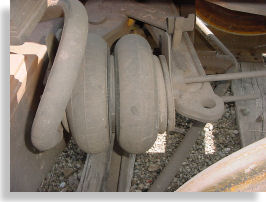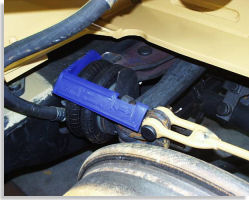Getting Adjusted
Pennsy Corporation maintains very collaborative relationships with their customers, so it was not a surprise for Pennsy engineers to receive a call about an issue one particular customer was having with their brake actuator indicators. The Pennsy engineering team was eager to dive right in.
It appeared that the customer had several rail cars that were equipped with an air brake travel indicator that inspectors in the yard used to visually determine any need for adjustment of the braking system. The indicator system consisted of two components that were welded in place at locations on the railcar undercarriage and brake rigging. The system worked sufficiently when the cars were newer, but inspectors found that as the various components of the train began to wear or when slack developed in the brake rigging, the current indicators became inaccurate and useless. As a result, brakes were being adjusted when they didn’t need to be or worse, they were being left as-is when an adjustment was absolutely necessary. The bottom line was that this problem posed potential safety risks for the railroad and caused the owners to incur additional, often unnecessary maintenance expenses for unneeded adjustments or premature wear due to improperly adjusted brakes.

A Universal Fit
The Pennsy engineering team needed to develop a replacement indicator system that was easier to read than the original, remained accurate regardless of railcar component wear or slack in the brake rigging, could endure the railroad environment, and was simple and cost-effective to install. Additionally, and likely the biggest challenge facing them, they had to design one system that would universally fit all of the customer’s affected railcars.
Recognizing that they had their work cut out for them, the Pennsy team quickly analyzed the commonalities between the various rail cars on which the original indicators were installed, paired that information with the customer requirements list, and hit the drawing boards.
Making it Work
In a short span of time, Pennsy engineers had settled upon a design for a new actuator gauge and presented a prototype to the customer. Drawing once again on their knowledge of advanced polymers, Pennsy engineers showed a design that would be cost-effective, could withstand the elements, and could be installed in a matter of minutes, easily and securely, and without the need for any tools, fasteners or welding.
As for the universal fit, the initial prototype installed without problems on most of the rail cars in question, but Pennsy encountered interferences with non-related components on the undercarriages of few of the railcars. For example, one car was found to have an air line in a location not shared with any others. Still others had a unique control rod that, when in its extended position, interfered with the gauge.

With continuous feedback and field testing, these issues were sorted out rather quickly, and the actuator gauge design was modified to account for the variances without further delay.
Right on Target
In the end the project goals were achieved and the customer was extremely satisfied with the Pennsy effort and, of course, the final product. They were especially pleased about the ease with which the new indicator could be installed – it essentially just snapped into place – and with how secure and durable the part was once in place on the car. They were also pleased to learn that installation of the new part did not require the removal of the original system.
It was also immediately clear that the nature of this new Pennsy system and its installation provided for easier and more accurate adjustment readings than before, and that those readings would not be affected at all by component wear over time. That advantage alone brought about the overarching benefit of eliminating potential safety risks from improperly adjusted brakes and lowering the maintenance costs tied to unnecessary car services.
Getting Pennsy Involved on Your Project
For over two decades Pennsy Corporation has designed and marketed innovative products to meet the specialized needs of the railroad industry. Our team of engineers has a combined service of over 120 years in the locomotive, freight and transit segments of the railroad industry. Pennsy excels in solving engineering problems using innovative thinking together with the latest technologies and in-house testing facilities for validation of new products. Our four-step R&D, Design, Testing and Manufacturing process enables us to collaborate closely and effectively with engineering divisions of major railroads, freight car builders and shippers to deliver the right solution.
This process ensures our customers the lowest total cost design solutions by providing quality products and reducing the overall application and maintenance cost of customer equipment.
To get the Pennsy team involved in addressing your railroad specific needs, contact Pennsy at questions@Pennsy.com.

